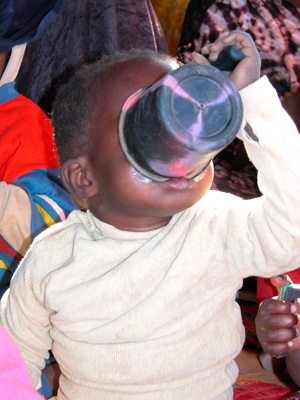What is hunger?
 Acute hunger or starvation are often highlighted on TV screens: hungry mothers too weak to breastfeed their children in drought-hit Ethiopia, refugees in war-torn Darfur queueing for food rations, helicopters airlifting high energy biscuits to earthquake victims in Pakistan or Indonesia.
Acute hunger or starvation are often highlighted on TV screens: hungry mothers too weak to breastfeed their children in drought-hit Ethiopia, refugees in war-torn Darfur queueing for food rations, helicopters airlifting high energy biscuits to earthquake victims in Pakistan or Indonesia.These situations are the result of high profile crises like war or natural disasters, which starve a population of food, yet emergencies account for less than eight percent of hunger's victims.
Daily undernourishment is a less visible form of hunger -- but it affects many more people, from the shanty towns of Jakarta in Indonesia and the Cambodian capital Phnom Penh to the mountain villages of Bolivia and Nepal. In these places, hunger is much more than an empty stomach.
2,100 calories a day
For weeks, even months, its victims must live on significantly less than the recommended 2,100 kilocalories that the average person needs to lead a healthy life.
The body compensates for the lack of energy by slowing down its physical and mental activities. A hungry mind cannot concentrate, a hungry body does not take initiative, a hungry child loses all desire to play and study.
Hunger also weakens the immune system. Deprived of the right nutrition, hungry children are especially vulnerable and become too weak to fight off disease and may die from common infections like measles and diarrhoea. Each year, almost 11 million children die before reaching the age of five; malnutrition is associated with 53 percent of these deaths (source: Caulfield et al., The American Journal of Clinical Nutrition. 2004 July)
Number 1 risk to health
In the final quarter of the 20th century, humanity was winning the war on its oldest enemy. From 1970-1997, the number of hungry people dropped from 959 million to 791 million -- mainly the result of dramatic progress in reducing the number of undernourished in China and India.
In the second half of the 1990s, however, the number of chronically hungry in developing countries started to increase at a rate of almost four million per year. By 2001-2003, the total number of undernourished people worldwide had risen to 854 million and the latest figure is 925 million.
Today, almost one person in six does not get enough food to be healthy and lead an active life, making hunger and malnutrition the number one risk to health worldwide -- greater than AIDS, malaria and tuberculosis combined.
How much food?
The energy and protein that people need varies according to age, sex, body size, physical activity and, to some extent, climate
The energy and protein that people need varies according to age, sex, body size, physical activity and, to some extent, climate
- Extra energy is needed during pregnancy and lactation
- On average, the body needs more than 2,100 kilocalories per day per person to allow a normal, healthy life
No comments:
Post a Comment